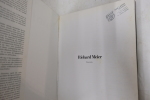-
Type
Any type (2)
Art print (7)
Book (30850)
Disk (1)
Drawings (7)
Engraving (9)
Magazine (129)
Old papers (1)
Photographs (14)
Posters (4)
-
Latest
Last 24h (9)
Last 3 days (7)
Last month (229)
Last week (129)
-
Language
Dutch (1)
English (54)
French (30923)
German (6)
Italian (18)
Japanese (2)
Portuguese (9)
Spanish (11)
-
Century
16th (16)
17th (56)
18th (209)
19th (1540)
20th (9204)
21st (1661)
-
Countries
Belgium (9485)
Brazil (7)
Canada (108)
China (3)
Côte d'Ivoire (67)
Denmark (218)
France (18072)
Germany (1)
Greece (1)
Italy (37)
Switzerland (3025)
-
Syndicate
ALAC (99)
CLAM (42)
CLAQ (94)
CNE (3)
ILAB (10651)
NVVA (1161)
SLACES (1161)
SLAM (8123)
SNCAO (9)
Architecture Now ! L'architecture d'aujourd'hui.
TASCHEN. 2002. In-12. Broché. Très bon état, Couv. fraîche, Dos satisfaisant, Intérieur frais. 191 pages. Nombreuses photos en couleurs, dans le texte et hors-texte.. . . . Classification Dewey : 720-Architecture
"""Icons"" Classification Dewey : 720-Architecture"
ARCHITECTURE NOW ! L ARCHITECTURE D AUJOURD HUI
TASCHEN. Non daté. In-8. Broché. Bon état, Couv. convenable, Dos satisfaisant, Intérieur frais. 191 pages augmentées de nombreuses illustrations en couleur dans et hors texte - NON DATE. . . . Classification Dewey : 720-Architecture
COLLECTION ICONS Classification Dewey : 720-Architecture
Architecture Now ! - L'Architecture d'aujourd'hui - collection icons
Taschen. . In-8. Broché. Bon état, Couv. convenable, Dos satisfaisant, Intérieur frais. 191 pages. Nombreuses illustrations en couleur dans et hors texte. Annotation sur la page de garde en fin d'ouvrage.. . . . Classification Dewey : 720-Architecture
Classification Dewey : 720-Architecture
Architecture Now ! L'architecture d'aujourd'hui.
TASCHEN, 2002. In-12 broché, couverture en couleurs, 191 pages. Nombreuses photos en couleurs, dans le texte et hors-texte. "Icons" In-12 Broché, texte en français. Très bon état.
BUILDING A NEW MILLENIUM. Bauen im Neuen Jahrtausend. Construire un nouveau Millénaire.
Taschen, 2000, in-4 hardcover ; 549 pp, illustrations. In english, french & german. Couverture en bon état, intérieur en très bon état.
Calatrava (Architecture & Design)
Taschen 2001 In-4 relié 30,7 cm sur 23,2. 176 pages. Très bon état d’occasion.
Très bon état d’occasion
Calatrava. Complete Works 1979 - today
Taschen Taschen, 2015. Grand In-4 relié plein cartonnage éditeur blanc au plat illustré sous jaquette illustrée rempliée de 595 pages. Nombreuses photos et plans, en noir et en couleur, dans et hors-texte. Très bon état
Toutes les expéditions sont faites en suivi au-dessus de 25 euros. Expédition quotidienne pour les envois simples, suivis, recommandés ou Colissimo.
Contemporary American Architects
Taschen Taschen, 1993. In-4 cartonnage souplé de 176 pages illustrées. Texte Anglais, Allemand, Français. Très bon état
Toutes les expéditions sont faites en suivi au-dessus de 25 euros. Expédition quotidienne pour les envois simples, suivis, recommandés ou Colissimo.
CONTEMPORARY AMERICAN ARCHITECTS. Volume 1, édition trilingue english deutsch français
Taschen 1993 Livre en français, anglais, allemand. In-4 broché 30 cm sur 22,5. 176 pages. Bon état d’occasion.
Bon état d’occasion
CONTEMPORARY AMERICAN ARCHITECTS. Volume III
Köln, Benedikt Taschen, 1997; in-4 softcover, 176 pp, illustrations. In english-french & deutsch. Very Good Condition.
CONTEMPORARY CALIFORNIA ARCHITECTS
Taschen 1997 In-4 broché 29,7 cm sur 22,4. 176 pages. Bon état d’occasion.
Bon état d’occasion
CONTEMPORARY CALIFORNIA ARCHITECTS. Volume I
Köln, Benedikt Taschen, 1995; in-4 softcover, 176 pp, illustrations. In english-french & deutsch. Very Good Condition.
Contemporary european architects - volume IV
Taschen. 1996. In-4. Broché. Bon état, Coins frottés, Coiffe en pied abîmée, Intérieur frais. 176 pages. Nombreuses photographies en couleurs dans et hors texte dont frontispice. Texte en regard Anglais/Allemand/Français. Couverture contre pliée.. . . . Classification Dewey : 720-Architecture
Classification Dewey : 720-Architecture
CONTEMPORARY EUROPEAN ARCHITECTS. Volume V.
Köln, Benedikt Taschen, 1997; in-4 softcover, 176 pp, illustrations. In english-french & german. Very Good Condition.
Formes nouvelles, architecture des années 90
Taschen Cartonné avec jaquette 1997 In-4, (31x24.5 cm), cartonné sous jaquette illustrée, 237 pages, iconographie en couleurs, bibliographie, index ; jaquette légèrement défraîchie, bon état. Livraison a domicile (La Poste) ou en Mondial Relay sur simple demande.
Formes nouvelles : Architectures des années 90
Taschen. Non daté. In-Folio. Relié. Bon état, Couv. convenable, Dos satisfaisant, Intérieur frais. 237 pages augmentées de nombreuses photos en couleurs dans et hors texte. Jaquette légèrement frottée.. Avec Jaquette. . . Classification Dewey : 720-Architecture
Classification Dewey : 720-Architecture
Ieoh Ming Pei
Chêne 2008 In-4 relié 28,6 cm sur 22,6. 368 pages. Très bon état d’occasion.
Cet ouvrage rend hommage à l’influence décisive de Pei à travers des entretiensexclusifs sur les différents projets dans lesquels il s’est investi personnellement, davantage, qu’aucun de ses collaborateurs. Des textes passionnants rédigés par des auteurs de renom, Philip Jodidio, Janet Adams Strong et Carter Wiseman, font de cette première monographie sur l’oeuvre de l’architecte une somme documentaire inestimable et qui fera date. Très bon état d’occasion
Mario Botta
Taschen 1999 176 pages 23x30x2cm. 1999. Cartonné jaquette. 176 pages.
proche du neuf
NEW FORMS. Architecture in the 1990S.
Köln, Benedikt Taschen, 1997; in-4 hardcover, dustjacket ,, 237 pp, illustrations. In english. Very Good Condition.
Piano. Renzo Piano Building workshop 1966-2005
Taschen, n° XI 2005 Livre en français, anglais . In-folio relié 45,7 cm sur 33.416 pages, sous jaquette. Très bon état d’occasion.
Très bon état d’occasion
Piano. Renzo Piano Building workshop 1966 to today
Taschen 2005 Livre en anglais-français-allemand. In-4 cartonnage éditeur sous jaquette 29,5 cm sur 23. 528 pages. Jaquette en bon état. Bon état d’occasion.
Bon état d’occasion
Richard Meier
Köln Taschen 1995 Paperback, 176pp.,23x30cm., richly illustr.
Acceptable. Title page missing.
RICHARD MEIER.
Köln, Benedikt Taschen, 1995; in-4 softcover, 175 pp, illustrations. In english-french & german. Very Good Condition.
RICHARD MEIER.
Köln, Benedikt Taschen, 1995; in-4 softcover, 175 pp, illustrations. In english-french & german. Ex-dono (writing) on 1st page. Cover in good condition, inside very good.
Richard Meier
Taschen Taschen, 1995. In-4 broché, couverture à rabat de 175 pages. Nombreuses photos. Très bon état
Toutes les expéditions sont faites en suivi au-dessus de 25 euros. Expédition quotidienne pour les envois simples, suivis, recommandés ou Colissimo.
 Write to the booksellers
Write to the booksellers

















